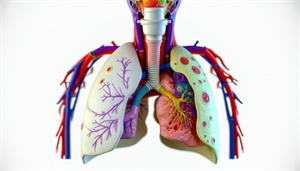Snoring and diabetes might seem like unrelated issues, but there’s growing evidence suggesting a significant connection. Those nightly disruptions could hint at a greater risk of developing diabetes, or impact those managing the condition. In this article, we tackle the nature of the relationship between diabetes and snoring, supporting you in understanding how snoring can reflect and affect diabetes risk.
Key Takeaways
-
Obstructive sleep apnea syndrome (OSAS) has a significant link with type 2 diabetes, impacting glucose metabolism and insulin resistance, thereby increasing diabetes risk.
-
Snoring, particularly frequent/habitual snoring, is a potential predictor for diabetes beyond other factors like body mass index, underscoring the importance of snoring patterns in diabetes risk assessment.
-
Lifestyle factors such as alcohol and tobacco use, alongside weight management and sleep quality, play critical roles in the risk and management of snoring and related conditions like diabetes.
Understanding Sleep Apnea and Its Connection to Type 2 Diabetes Mellitus

Sleep apnea, a condition marked by interrupted breathing during sleep, is more than just a cause of daytime drowsiness and loud, disruptive snoring at night. It’s a sleeping disorder that poses serious health risks. One such risk is the development of type 2 diabetes mellitus, a chronic condition that affects the way your body metabolizes glucose.
Obstructive sleep apnea syndrome (OSAS), the most common form of sleep apnea, is especially linked to diabetes. In a study by Elmasry and colleagues, patients with obesity and OSAS had notably elevated levels of fasting blood glucose and fasting serum insulin compared to patients without OSAS. This finding indicates a significant impact on glucose metabolism, a key factor in the development of diabetes.
Further research has confirmed this connection. A study involving Chinese adults found that habitual snoring, a common symptom of sleep apnea, was identified as a risk factor for type 2 diabetes. This link held true even when taking into account body mass index, family history of diabetes, and self reported snoring.
Defining Obstructive Sleep Apnea Syndrome
You might wonder what Obstructive Sleep Apnea Syndrome (also known as obstructive sleep apnoea syndrome), or OSAS, really is. Well, it’s a sleep disorder that manifests as excessive daytime sleepiness, loud snoring, and episodes of stopped breathing during sleep. This often results in waking up with gasping or choking. The typical indicators also encompass morning symptoms such as a dry mouth or sore throat.
OSAS primarily stems from the relaxation and constriction of the throat walls when you sleep, which can obstruct the upper airway, leading to interrupted breathing. This can also contribute to the development of other health issues, such as chronic kidney disease, due to its impact on glucose metabolism and blood pressure regulation.
The Impact on Glucose Metabolism
Sleep apnea significantly alters glucose metabolism. Sleep apnea, particularly obstructive sleep apnea (OSA), induces physiological alterations in glucose metabolism, including glucose intolerance and insulin resistance. These alterations are worsened by intermittent hypoxia and systemic inflammation during sleep apnea episodes.
Insulin resistance is intricately linked to sleep apnea. It disrupts glucose metabolism as a result of sleep disturbances. The heightened insulin resistance is a separate consequence of sleep apnea that can contribute to the onset of type 2 diabetes.
The disruptions in glucose metabolism, including impaired glucose regulation and beta-cell dysfunction brought on by sleep apnea, can markedly elevate the likelihood of developing type ii diabetes mellitus.
This shows how sleep apnea goes beyond causing broken sleep and loud snoring - it can fundamentally disrupt the body’s metabolic processes, leading to more severe health conditions.
Linking Sleep Apnea Syndrome to Diabetes Risk
The connection between sleep apnea syndrome and the risk of developing type 2 diabetes is more than just a theory. It is a proven correlation backed up by a substantial body of research. Sleep apnea contributes to the development of Type 2 diabetes by affecting glucose metabolism, fostering insulin resistance, and elevating the likelihood of diabetes development.
The prevalence of Type 2 diabetes among individuals diagnosed with sleep apnea syndrome ranges from 29% to 48%. This is a significant proportion, indicating that sleep apnea is a serious risk factor that cannot be ignored.
The severity of sleep apnea can impact the risk of developing Type 2 diabetes. Research has demonstrated a positive correlation between the severity of sleep apnea and the occurrence of Type 2 diabetes. This correlation maintains its significance even when adjusting for factors such as adiposity. Consequently, individuals with more severe sleep apnea are at an elevated risk of developing Type 2 diabetes.
Snoring Frequency and Its Role as a Predictor of Diabetes

Although sleep apnea is a major concern, it isn’t the sole sleep-related factor associated with diabetes. Snoring frequency, too, has been identified as a potential predictor of diabetes risk. In fact, research has shown that habitual snoring is associated with a greater risk of prediabetes and type 2 diabetes compared to occasional snoring.
This association isn’t a mere coincidental correlation. Women who habitually snore have a fivefold higher risk of developing diabetes compared to those who do not snore. It is worth noting that adjusting for body mass index significantly reduced the relative risks of developing diabetes for snorers, suggesting a notable interaction between snoring frequency and other diabetes risk factors.
Hence, comprehending a person’s snoring patterns, especially the frequency of their snoring, could help gauge their risk of developing diabetes. This knowledge could help in early detection and intervention, possibly preventing the onset of diabetes in individuals who snore frequently.
From Occasional to Habitual: Snoring Patterns
Snoring patterns vary from occasional to habitual, and deciphering these patterns can be vital in evaluating diabetes risks. Occasional snoring is commonly attributed to the vibration of tissues in the throat, obstructed airflow, chronic nasal congestion, sleeping position, and the anatomy of the mouth and sinuses. Additional factors may include alcohol consumption, allergies, weight gain, sedative medications, and hormonal shifts.
However, the transition from occasional snoring to self reported habitual snoring may be influenced by factors such as:
-
weight gain
-
pregnancy
-
use of sedative medications
-
increased congestion
-
the development of sleep disorders such as obstructive sleep apnea
These factors can result in a narrowing of the airway and increased difficulty in airflow during sleep, which can lead to more frequent snoring.
The Influence of Snoring on Blood Glucose Levels
Snoring doesn’t merely interrupt sleep - it can notably influence blood glucose levels as well. An increased frequency of snoring has been associated with elevated blood glucose levels and an increased risk of developing diabetes. This association holds true across various demographic groups, such as premenopausal and postmenopausal women, and seems to be unrelated to obesity. Therefore, even individuals who are not overweight or obese could be at risk if they snore frequently.
Snoring contributes to impaired glucose metabolism by initiating metabolic processes that impact insulin function and glucose regulation. Additionally, snoring can lead to heightened sympathetic activity, which affects glucose balance.
Adiposity Measures: BMI and Diabetes Mellitus in the Context of Snoring

Beyond sleep apnea and snoring, adiposity - the amount of body fat, is another factor to consider when discussing diabetes. Measures of adiposity, such as body mass index (BMI) and waist circumference, can play a crucial role in determining the risk of diabetes.
These measures are not just numbers on a scale or tape measure. They serve as indicators of body fat distribution, which significantly impacts the likelihood of snoring and the subsequent onset of type 2 diabetes. Thus, maintaining a healthy body weight and waist circumference is crucial not just for general health, but specifically for reducing the risk of snoring and diabetes.
These adiposity measures are not isolated factors – they are intertwined with other elements like snoring and sleep apnea. Therefore, a comprehensive approach addressing all these interconnected components is necessary for the effective prevention and management of diabetes.
The Interplay Between BMI and Snoring
BMI, a commonly used body fat index, can affect both snoring and diabetes. An elevated BMI can contribute to the occurrence of snoring through various physiological changes, such as an elevated likelihood of airway obstruction and reduced sleep quality. These changes can lead to breathing disturbances, including snoring, during sleep.
The link between high BMI and the prevalence of sleep apnea is robust, with obesity being a significant risk factor due to the heightened pressure it exerts on the upper airways. Therefore, maintaining a healthy BMI is not just beneficial for overall health, but it can also contribute to reducing the risk of snoring and diabetes.
Waist Circumference and Insulin Resistance
Another significant indicant of adiposity is waist circumference. A larger waist circumference has been linked to insulin resistance, which can contribute to the development of diabetes.
Waist circumference is a reliable indicator of abdominal adiposity, particularly intra-abdominal visceral fat. This type of fat is linked to insulin resistance and an elevated likelihood of developing diabetes.
Thus, maintaining a healthy waist circumference can play a crucial role in reducing the risk of diabetes and improving overall health. It’s a simple measure that can provide valuable insights into our metabolic health, and taking steps to keep it within a healthy range can go a long way in preventing conditions like diabetes.
Cardiovascular and Metabolic Diseases: Snoring's Broader Health Implications

Snoring and sleep apnea aren’t merely disruptive to sleep - they bear wider health implications. In particular, they have been linked to cardiovascular and metabolic diseases, which are serious conditions that can significantly impact health and quality of life.
One key health concern linked to snoring is cardiovascular disease. Sleep apnea, a common cause of snoring, is a known risk factor for cardiovascular diseases. This connection exists because sleep apnea can result in decreased oxygen levels and heightened stress on the heart, ultimately contributing to the development of diseases like coronary artery disease.
Sleep-disordered breathing, including snoring, has also been associated with metabolic syndrome, a cluster of conditions that increase the risk of heart disease, stroke, and diabetes. Obesity is a common risk factor for both conditions, and hypertension, or high blood pressure, is the main factor linked to an OSA diagnosis in patients with metabolic syndrome.
Beyond Diabetes: Snoring and Cardiovascular Health
Although diabetes is a major health concern tied to snoring, it isn’t the sole issue. Cardiovascular health issues, such as hypertension and coronary artery disease, are also linked to snoring. Research indicates that snoring is an independent indicator of:
-
hypertension in both males and females
-
cardiovascular complications including an elevated risk for cardiovascular disease events
-
hypertension
-
atrial fibrillation
-
heart failure
-
coronary artery disease
The increased risk of coronary artery disease can be attributed to snoring as it is a symptom of sleep apnea, which can result in decreased oxygen levels and heightened stress on the heart. However, there is a silver lining – treating sleep apnea and snoring with therapies like CPAP can reduce the risk of developing or succumbing to heart disease, as well as enhance heart function.
Metabolic Syndrome and Sleep Disordered Breathing
Metabolic syndrome is a cluster of conditions that increase the risk of heart disease, stroke, and diabetes, which are all considered cardiovascular risk factors and chronic diseases. It includes:
-
High blood pressure
-
High blood sugar
-
Excess body fat around the waist
-
Abnormal cholesterol or triglyceride levels
Sleep-disordered breathing, particularly obstructive sleep apnea (OSA), is correlated with metabolic syndrome.
Snoring has been found to have a significant impact on the development of metabolic syndrome. Loud snoring has been associated with a twofold increase in the likelihood of developing metabolic syndrome and can predict specific metabolic irregularities such as high blood sugar levels and low HDL cholesterol levels.
The good news is that treating sleep-disordered breathing, including obstructive sleep apnea, can lead to an improvement in symptoms of metabolic syndrome. Continuous positive airway pressure (CPAP) treatment has been shown to enhance insulin sensitivity and reduce glucose intolerance in individuals with sleep-disordered breathing.
Lifestyle Factors Affecting Snoring and Diabetes Risk

Our lifestyle choices considerably influence our health, which holds true for both snoring and diabetes risk. Factors such as alcohol consumption, tobacco use, and sleep quality can all play a role in determining the likelihood of developing these conditions.
While it might seem that snoring and diabetes are only related to physical factors like body weight and sleep patterns, lifestyle factors can also contribute significantly. Poor lifestyle choices can lead to a higher risk of developing these conditions and can also make it harder to manage them if they do develop.
The good news is that by making positive lifestyle changes, we can significantly reduce our risk of snoring and diabetes. This not only involves:
-
managing our weight and ensuring we get enough quality sleep
-
reducing our alcohol consumption
-
avoiding tobacco
-
engaging in regular physical activity
The Role of Alcohol and Tobacco
Two lifestyle factors that can notably influence the risk of snoring and diabetes are alcohol and tobacco. Both of these substances can negatively impact sleep quality, which in turn can increase the risk of snoring and disrupt glucose metabolism, leading to an increased risk of diabetes.
Tobacco use, particularly smoking cigarettes, is linked to an elevated probability of experiencing snoring and sleep apnea. This is because smoking can diminish sleep quality and exacerbate respiratory function, thereby contributing to the development of these sleep disorders.
On the other hand, alcohol impacts sleep quality in the following ways:
-
It is a central nervous system depressant, leading to disturbances in the sleep cycle.
-
It can increase the time it takes to fall asleep.
-
It can cause changes in non-rapid eye movement (NREM) sleep.
-
It can decrease rapid eye movement (REM) sleep.
-
It can reduce total sleep duration.
Importance of Sleep Duration and Quality
Sleep isn’t merely a resting phase. It’s a vital aspect of our overall health, influencing everything from our mood, energy levels, to our susceptibility to chronic conditions like diabetes. Adequate sleep duration and quality are essential for maintaining overall health and reducing the risk of diabetes and other chronic conditions.
Inadequate sleep quality can elevate the likelihood of snoring and diabetes through multiple mechanisms. Conditions like sleep apnea can contribute to insulin resistance, a known risk factor for diabetes. Additionally, obesity, commonly associated with snoring and sleep apnea, can heighten the risk of diabetes.
On the other hand, enhancing sleep quality has the potential to lead to a reduction in the risk of diabetes. Research has indicated that both insufficient and excessive sleep, along with poor sleep quality, are associated with an increased risk of diabetes. Therefore, implementing measures to improve sleep quality can be advantageous in mitigating the risk of diabetes.
Preventative Measures and Management Strategies
The adage ‘prevention is better than cure’ applies aptly to both snoring and diabetes. There are several preventative measures and management strategies that can help reduce the risk of these conditions, including weight management, physical activity, and continuous positive airway pressure (CPAP) therapy.
Weight management can significantly aid in:
-
Preventing diabetes
-
Reducing the frequency of snoring
-
Improving sleep apnea, a common cause of snoring, thus decreasing the severity and frequency of snoring episodes
-
Preventing the onset of type 2 diabetes.
Physical activity is another crucial factor. Engaging in physical activity offers several benefits for individuals at risk of diabetes and obstructive sleep apnea. It aids in preventing and managing diabetes by facilitating weight control, improving insulin sensitivity, and ensuring better glycemic control. Additionally, physical activity can lower the risk of noncommunicable diseases that frequently accompany diabetes.
Weight Management and Physical Activity
Maintaining a healthy weight is a key factor in reducing the risk of both snoring and diabetes. Excess weight can increase the risk of developing these conditions by placing pressure on the upper airways, leading to the obstruction that causes sleep apnea and snoring. Furthermore, obesity is a significant risk factor for the development of type 2 diabetes.
Physical activity is another important factor. Regular exercise can help decrease snoring and enhance the quality of sleep. Furthermore, engaging in regular physical activity is linked to a reduced risk of developing type 2 diabetes. Therefore, incorporating regular physical activity into your daily routine can improve both your sleep quality and your metabolic health.
Continuous Positive Airway Pressure (CPAP) Therapy
Continuous Positive Airway Pressure (CPAP) therapy is a commonly employed treatment for obstructive sleep apnea. It involves the use of a CPAP machine to administer a steady flow of gentle air pressure, which serves to uphold an unobstructed airway and facilitate regular breathing patterns during sleep.
CPAP therapy aids in the management of sleep apnea by administering pressurized air through a mask to maintain the openness of the airway during sleep. This prevents its collapse and facilitates normal breathing throughout the night. By preventing the disruption of breathing during sleep, CPAP therapy can significantly improve sleep quality and reduce the frequency and severity of snoring.
Moreover, there’s good news for those with diabetes or at risk of developing the condition. CPAP therapy diminishes the likelihood of developing type 2 diabetes by enhancing blood glucose levels and stability, reducing insulin resistance, and improving glycemic control in individuals with sleep apnea.
Summary
In conclusion, snoring, sleep apnea, and diabetes are interconnected, with each condition influencing the others. By understanding these links and taking proactive steps to manage our sleep and overall health, we can significantly reduce our risk of developing these conditions. Remember, a good night’s sleep isn’t just about rest – it’s a crucial part of overall health and wellness.
Frequently Asked Questions
Is sleep apnea a symptom of diabetes?
Yes, sleep apnea can be a symptom of diabetes, and both conditions are often related to obesity and can impact each other's management. It's important for diabetic patients to also consider managing their sleep quality.
What is the average life expectancy of a Type 2 diabetic?
The average life expectancy of a Type 2 diabetic is estimated to be 14, 10 and 6 years less than individuals without the condition when diagnosed at ages 30, 40, and 50 years, respectively. So, it may vary depending on the age at diagnosis.
What is diabetes burnout?
Diabetes burnout is feeling overwhelmed or exhausted by the physical and emotional stress of managing type 2 diabetes, which may lead to neglecting one's care plan and feeling unable to cope. This can result in skipping insulin doses or neglecting self-care.
What are the symptoms of diabetes while sleeping?
High blood sugar levels can lead to frequent urination, disrupting sleep, and causing symptoms such as headaches, increased thirst, and tiredness that interfere with falling asleep.
How is the categorization and assessment of snoring frequency conducted?
Snoring frequency is categorized as 'never', 'occasionally', and 'habitual' based on the individual's self-reported snoring frequency over the past 12 months. This assessment corresponds to 'never or nearly never', '1–2 nights per week', and '3 nights per week', respectively.


